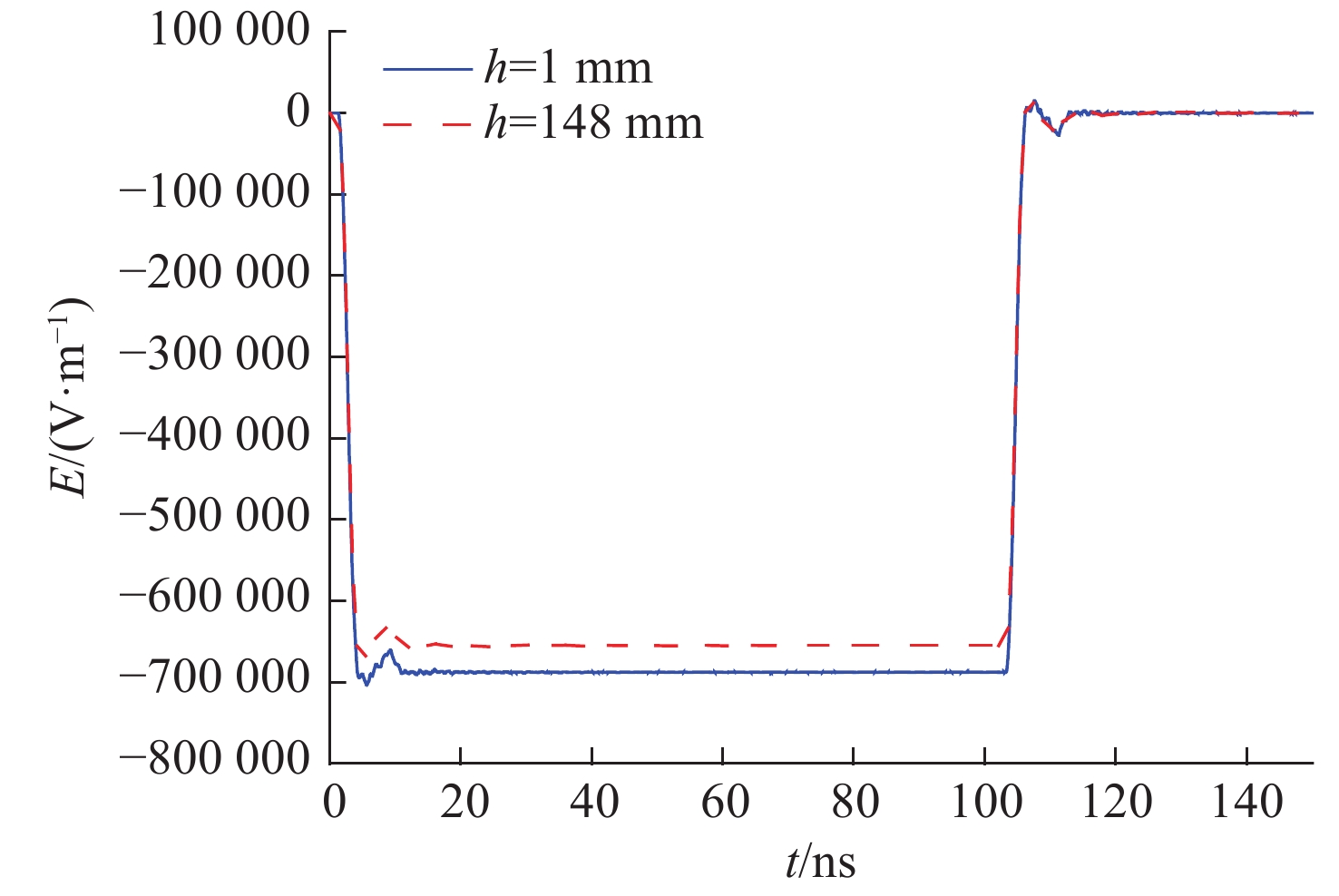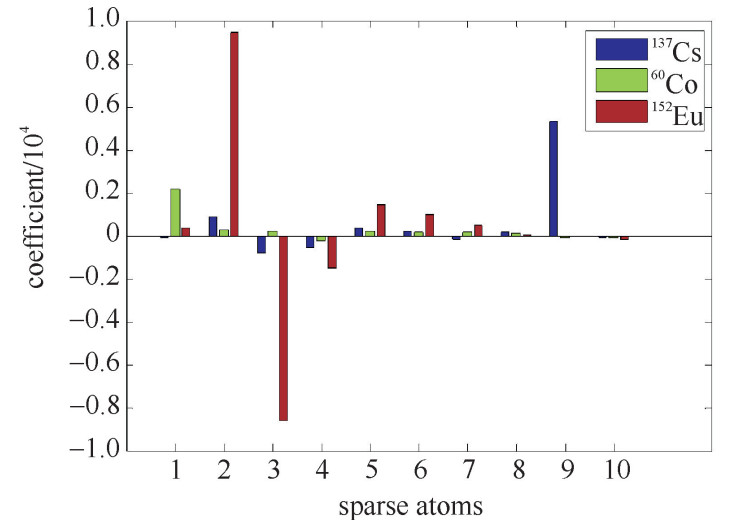Electric field probe calibration and improvement method based on open TEM cell
-
摘要: 目前的电场探头标定实验大多只考虑TEM小室结构和性能的影响,在校准实验中,探头的放入使得标定结果产生了很大的偏差,相较于TEM小室,电场探头的尺寸是产生误差的主要原因。以开放式TEM小室为基础,考虑了实际模型和电场探头的影响,利用三维电磁仿真软件,从时域角度研究了不同结构和尺寸TEM小室的辐射场分布,并从频域角度对TEM小室的S参数进行分析。比较了探头放入小室前后的误差,并根据计算结果引入了电场的校准公式。为改善探头对电场的影响,设计了一种新型结构,结果表明,新结构在保证带宽的同时,提高了电场的均匀性和探头标定的准确度。Abstract: Most of the calibration experiments of the electric field probe only consider the influence of the structure and performance of the TEM cell. In the calibration experiment, the placement of the probe makes the calibration result produce a large deviation. Therefore, the main reason for the error is the size of the probe, rather than the TEM cell. Taking the actual model and electric field probe into account, in this paper, the radiation field distribution of TEM cells with different structures and sizes is studied from the time domain perspective based on open TEM cells, while the S-parameters of TEM are analyzed from the frequency domain perspective using 3D electromagnetic simulation software. In addition, this paper compares the errors before and after the probe is placed in the chamber, and introduces the electric field calibration formula based on the calculation results. In order to improve the influence of the probe on the electric field, a new structure was designed. The results show that the new structure not only guarantees the bandwidth, but also improves the uniformity of the electric field and the accuracy of the probe calibration, which provides a new idea for the design of the TEM cell and the calibration of the probe.
-
Key words:
- TEM cell /
- electric field probe /
- probe disturbance /
- electric field uniformity /
- calibration formula
-
放射性核素识别是核安全领域的关键问题之一,其旨在通过对探测器获取的放射性核素伽马能谱进行分析,获取放射性物质组成元素的种类与含量等信息。传统核素识别方法将能谱特征峰相关信息作为核素特征与标准核素库进行比对,以此判断核素的种类[1-3]。如何快速准确获得特征峰相关信息成为此类方法的关键,然而探测器噪声[4]、本底辐射[5]等会对寻峰及识别带来一定的影响,因此,传统的核素识别方法主要集中于寻峰方法的研究,常见的寻峰方法有导数法、对称零面积法等[6]。核素识别问题本质上是分类问题,提取何种特征才能有效地表征能谱是值得研究的问题。本文提出了一种基于稀疏表示[7]的核素能谱特征提取方法,将核素能谱作为“时间”序列看待,从序列结构着手,对能谱在稀疏字典上进行顺次分解,并将分解系数向量作为能谱特征。与经典稀疏分解方法不同,该方法在分解过程中对核素能谱按照稀疏字典中的原子排列顺序顺次进行分解;其次,核素识别要求不同核素在所提特征下的可区分性,提取到的特征(分解系数)对不同核素具有可区分性即可,并不要求核素能谱的重构精度,所以只选取若干最具区分性的特征表征核素能谱。
1. 核素能谱特征提取及其识别
1.1 伽马能谱稀疏分解
信号稀疏表示是一种通过较少的特定信息去尽可能准确地表示原始信号的方法。在稀疏表示方法中,信号可以用不同基信号的线性叠加表示,这些基信号的集合被称为字典,基信号又被称为原子。信号的稀疏表示是指在一个过完备字典库中,选择尽量少的原子表达原始信号,使得信号的表示更加简洁。
设待分解能谱信号为y,y为一个长度为M的列向量,过完备稀疏字典矩阵D=(x1, x2, …, xd),字典中的每个原子xi的长度都与信号y的长度M相同,即D为M×d的矩阵,且每个原子都由一个高斯函数构成,即
xi(t)=(s)−1/2⋅g[(t−u)/s]⋅cos(vt+w) (1) 式中:xi为字典矩阵D中的第i个原子;g为高斯函数;原子xi由参数(s, u, v, w)决定;s为尺度因子;u为位移因子;v为原子频率;w为原子相位。稀疏字典可以通过参数构造或者学习得到,本文采用参数字典。基于稀疏表示的核素能谱特征提取方法具体步骤如下:
(1) 核素能谱稀疏分解。按照稀疏字典D中原子顺序,计算信号y与字典矩阵中第一个原子的内积,即
ω1=⟨y,xr1⟩ (2) 式中: r1为第1个原子在字典中的列索引。信号y被分解为在xr1上的垂直投影分量和残差分量,即
y=⟨y,xr1⟩xr1+R1f (3) (2) 对残差信号逐次分解得到每个原子上的分解系数,第k+1次分解后的残差信号为
Rkf=⟨Rkf,xrk+1⟩xrk+1+Rk+1f (4) 经过k+1次分解后,能谱信号y被分解为:
y=k∑n=0⟨Rnf,xrn+1⟩xrn+1+Rk+1f (5) 其中,R0f=y,ωk+1=⟨Rnf,xrn+1⟩为第k+1次稀疏分解的系数,xrk+1为稀疏字典D第k+1个原子,Rk+1f为残差分量。
(3) 逐次进行上述分解过程,直到求得能谱信号在系数字典所有原子上的稀疏系数。
1.2 特征提取及核素识别
稀疏分解得到的系数向量(ω1, ω2, …, ωd)可以作为核素能谱的特征向量表征能谱,但是特征数目过多会给后续分类模型建立带来过大的计算量,有时过训练问题也会出现,所以需要对所得特征进行筛选。
设G表示筛选得到的原子集合,并初始化为G=Φ。对于每一个类别的核素能谱均不放回地随机抽取一个核素能谱y,按上述方法对其进行稀疏分解,并找到其稀疏分解最大系数(考虑到稀疏分解系数有可能为负,这里的最大系数指绝对值最大)所对应的原子x,即
|⟨y,x⟩|=maxi∈{1,2,⋯,d}{|⟨y,xi⟩|} (6) 将最大系数对应的原子x按照式(7)所示方式并入原子集合G,
G={G∪{x}, if x∉GG, otherwise (7) 重复上述过程,直到|G|=Ngs,Ngs为事先设定的阈值。将G中的原子按照其在稀疏字典D中的顺序进行排序。对于任意一个核素能谱y,其系数向量记为
t=(t1,t1,⋯,tNgs) (8) 式中:ti为能谱y在G中第i个原子上的系数,这里认为G中原子顺序已定。
图 1为137Cs,60Co,152Eu各随机选取一个能谱进行稀疏分解提取到的系数向量图,从图中可以看出,根据上述方法提取到的核素特征对三个不同种类的核素能谱具有较好的区分能力。
为了利用模式识别算法进行核素识别,将该核素的类别信息加入特征向量t,即t=(t1, t1, …, tNgs, c), 其中c表示该核素类别。多个核素能谱(多个类别)的特征向量集,即模式识别算法的训练样本集可表示为X,X={ti}={(t1it2i, …, tNgsi, ci)},i=1, 2, …, N,其中N为能谱个数。利用训练样本集,通过模式识别算法可得到核素分类模型,利用此分类模型即可进行未知类别核素能谱的识别。
2. 实验结果与分析
2.1 实测能谱核素识别实验
为了验证所提方法的有效性,对比了基于稀疏表示的特征提取方法与两种传统核素特征提取方法的分类准确率,这两种传统方法分别是:Savitzky-Golay(SG)平滑结合导数寻峰的方法和梯形窗平滑(TS)结合导数寻峰的方法。实验数据采用241Am, 133Ba, 60Co, 137Cs, 131I和152Eu共6种核素1200个核素能谱数据,分别在7个模式识别分类算法上进行了对比实验,这7种模式识别分类方法分别是:最近邻分类算法[8](KNN)、朴素贝叶斯分类算法[9](NavieBayes)、支持向量机算法[10](SMO), PART Decision List算法[11](PART), C4.5决策树分类算法[12](C4.5), CART决策树分类算法[13](CART)和RBF神经网络算法[14](RBFNetwork)。实验采用十折交叉验证法进行,即将6种核素1200个核素能谱数据均匀划分为10份,其中9份作为训练数据,另外1份作为测试数据,依次循环10次,分类准确率为10次实验的平均值。
表 1给出了三种不同特征提取方法所提特征在不同分类方法上的分类结果。可以看到,基于稀疏表示的特征提取方法的识别率普遍高于90%,分类效果较好;而两种传统的特征提取方法识别率均较低,在SMO方法上甚至低至20%以下。可以认为基于稀疏表示的特征提取方法能够有效地提取到区分能力更强的能谱特征,其原因在于该方法选择区分能力最好的稀疏原子分解系数作为能谱特征。
表 1 三种特征提取方法在模拟核素上的识别结果Table 1. Classification results of the three feature extraction methodsmethods sparse representation(rank) SG +derivative(rank) TS+derivative(rank) KNN 97.11%(1) 88.75% (2) 72.67% (3) NavieBayes 88.57%(1) 44.58% (2) 38.92% (3) SMO 72.86%(1) 19.50% (3) 21.83% (2) PART 96.00%(1) 91.25% (2) 78.00% (3) J48 96.86%(1) 90.83% (2) 74.42% (3) CART 96.29%(1) 89.50% (2) 76.00% (3) RBFNetwork 94.29%(1) 73.17% (2) 58.00% (3) mean 91.71%(1) 71.08%(2.14) 59.98%(2.86) 2.2 实验结果统计分析
Demsar[15]结合统计学原理,针对多个分类器在多个数据集上的分类结果比较问题,提出了一种统计分析比较的方法。该方法利用Friedman test和Holm test检验各个分类器的分类结果之间是否存在明显差异。在本实验中,首先利用Friedman test方法检验各个特征提取方法之下的分类结果是否存在明显差异。若存在明显差异,再利用Holm test方法具体比较基于稀疏表示的特征提取方法和另外两种特征提取方法的分类结果之间是否存在明显差异。
不同的特征提取方法在各个分类器下的分类结果不尽相同,Friedman test将这些分类准确率进行排序,对任意一个分类器而言,每种特征提取方法在其上的分类结果将被排序,每种特征提取方法都会得到唯一的一个序数值,如表 1所示。假设共有N个分类器、k种不同的特征提取算法,每一种特征提取算法在每个分类器下都进行了分类实验。首先用rij表示第i种分类器在第j种特征提取方法下的序数值。再计算每一种特征提取方法的均序Rj,Rj=1N∑jrji。Friedman test假设所有k种特征提取方法下的核素分类结果相同,Friedman统计量表达式为
χ2F=12Nk(k+1)(∑jR2j−k(k+1)24) (9) 该统计量服从卡方分布,其自由度为k=1。
在本实验中,N=7,k=3,χF2=12.31,该结果表明在α=0.05时(即显著性水平为0.05),3种特征提取方法下的核素分类结果相同的假设被拒绝,即本实验考虑的3种特征提取方法的分类结果具有明显的差异。
利用Holm test方法来检验基于稀疏表示的特征提取方法分类结果和另外2种特征提取方法的分类结果之间是否存在明显的差异。比较两个分类器的统计量为
z=R1−R2√k(k+1)6N (10) Holm test具体过程如下:根据z值在标准正态分布表中找到对应的概率p,按从小到大的顺序对多次两两比较中得到的p进行排列,记为p1, p2, …, pk-1。Holm test将对pi和α/(k-i)的大小进行比较,如果α/(k-i)大于或等于pi,则拒绝原假设(原假设为:pi对应的两个分类器具有相同的分类效果)。
本实验中,从表 1可以得到,R1=1,R2=2.14,R3=2.86,R1为基于稀疏表示的特征提取方法的均序值,R2和R3分别代表SG平滑+导数寻峰的均序值和梯形平滑+导数寻峰的均序值。在显著性水平为α=0.05的情况下,由k=3及N=7可以计算得到标准误差SE=√k(k+1)6N=√3×46×7=0.5354。Holm test的具体结果如表 2所示。
表 2 Holm检验Table 2. Holm testi methods z=(Ri-R1)/SE p α/(k-i) 1 TS+derivative peak seeking (2.86-1)/0.535 4=3.479 7 0.000 5 0.025 0 2 SG+derivative peak seeking (2.14-1)/0.535 4=2.132 7 0.032 9 0.050 0 Holm test排除了两个原假设,即在显著性水平为α=0.05的情况下,基于稀疏表示的特征提取方法的分类结果与SG+导数寻峰和梯形平滑+导数寻峰特征提取方法的分类结果之间存在显著差异,而从表 1可以看到,前者的分类准确率明显高于后两者的分类准确率,可以认为,所提方法的分类准确率显著地高于上述两种方法的分类准确率。
3. 结论
基于稀疏表示的特征提取方法将核素能谱视作时间序列,从整体上分析其结构特征,利用稀疏分解方法提取能谱特征,避免了谱光滑、寻峰等操作。在6种核素共1200个核素能谱上的识别实验结果表明该方法所提特征对不同核素具有可区分性,实验结果的统计分析表明对于核素识别而言,该特征提取方法显著地优于导数寻峰法,所提特征能够更好地表征核素能谱的结构特性。如果核素能谱数据中既包含强噪声背景下的核素能谱,又包含弱噪声背景下的同一种核素能谱,此方法的识别效果就会有一定的下降,此时可以先对能谱数据进行去噪,在以后的工作中,将针对此问题进行研究。
-
表 1 电场分布及误差
Table 1. Electric field distribution and error
measuring
point/mmamplitude/(V·m−1) error/% amplitude/(V·m−1) error/% amplitude/(V·m−1) error/% amplitude/(V·m−1) error/% d=149 mm d=199 mm d=249 mm d=299 mm (0,0, 1) 68843 2.56 51550 2.59 41207 2.60 34334 2.66 (0,0, 40) 68197 1.61 51313 2.11 41065 2.25 34184 2.21 (0,0, 80) 66901 0.32 50671 0.84 40887 1.81 34032 1.76 (0,0, 120) 65741 1.77 49910 0.46 40223 0.15 33775 0.99 (0,0, 160) — — 49318 1.86 39891 0.67 33401 0.12 (0,0, 200) — — — — 39573 1.46 33063 1.14 (0,0, d-1) 65501 2.40 49106 2.28 39199 2.40 32623 2.45 表 2 放入探头的电场分布及误差
Table 2. Electric field distribution and error after the probe is placed
insulation
sizemeasuring
point/mmamplitude/(V·m−1) error/% amplitude/(V·m−1) error/% amplitude/(V·m−1) error/% amplitude/(V·m−1) error/% d=149 mm d=199 mm d=249 mm d=299 mm l1=2 mm
l2=18 mm(0,0, 1) 78275 16.63 54525 8.51 42449 5.70 34973 4.57 (0,0, 40) 80811 20.41 54913 9.28 42541 5.93 35071 4.86 (0,0, 80) 88251 31.49 56975 13.38 42817 6.61 35121 5.01 (0,0, 120) — — 62002 23.38 44270 10.23 35275 5.47 (0,0, 160) — — — — 47509 18.30 36282 8.48 (0,0, 200) — — — — — — 39134 17.01 (0,0, d−51) 89744 33.72 64210 27.78 51174 27.42 43536 30.17 l1=10 mm
l2=10 mm(0,0, 1) 81041 20.75 55809 11.06 43097 7.31 35154 5.11 (0,0, 40) 84301 25.61 56469 12.37 43213 7.60 35284 5.50 (0,0, 80) 93231 38.91 59454 18.31 43772 8.99 35418 5.90 (0,0, 120) — — 66239 31.82 45946 14.40 35702 6.75 (0,0, 160) — — — — 51000 26.99 37055 10.79 (0,0, 200) — — — — — — 40062 19.78 (0,0, d−51) 95022 41.58 69146 37.60 55534 38.28 45989 37.51 表 3 改进结构的电场分布及误差
Table 3. Electric field distribution and error of improved structure
measuring
point/mmamplitude/(V·m−1) error/(%) amplitude/(V·m−1) error/% amplitude/(V·m−1) error/% amplitude/(V·m−1) error/% d=149 mm d=199 mm d=249 mm d=299 mm (0,0, 1) 68829 2.56 51688 2.85 41286 2.80 34512 3.19 (0,0, 40) 68313 1.79 51361 2.21 41127 2.41 34213 2.30 (0,0, 80) 67034 0.12 50797 1.09 40824 1.65 34019 1.72 (0,0, 120) 65880 1.84 50065 0.37 40345 0.46 33720 0.83 (0,0, 160) — — 49405 1.68 39871 0.72 33438 0.02 (0,0, 200) — — — — 39514 1.61 33120 0.97 (0,0, d−1) 65598 2.26 49214 2.06 39332 2.06 32738 2.11 -
[1] 李欣, 张雪芹, 曹保锋, 等. 电磁脉冲电场探头校准装置及不确定度评定[J]. 核电子学与探测技术, 2014, 34(8):1007-1010,1023. (Li Xin, Zhang Xueqin, Cao Baofeng, et al. Standard device of nuclear explosion electromagnetic pulse and evaluation of uncertainty[J]. Nuclear Electronics & Detection Technology, 2014, 34(8): 1007-1010,1023 doi: 10.3969/j.issn.0258-0934.2014.08.021Li Xin, Zhang Xueqin, Cao Baofeng, et al. Standard device of nuclear explosion electromagnetic pulse and evaluation of uncertainty[J]. Nuclear Electronics & Detection Technology, 2014, 34(8): 1007-1010, 1023 doi: 10.3969/j.issn.0258-0934.2014.08.021 [2] 郭启勇, 梁琼崇, 骆德汉, 等. 基于TEM小室的电场探头校准及其不确定度评定[J]. 广东工业大学学报, 2016, 33(3):19-25. (Guo Qiyong, Liang Qiongchong, Luo Dehan, et al. An electric field probe calibration based on TEM cell and evaluation of its uncertainty[J]. Journal of Guangdong University of Technology, 2016, 33(3): 19-25 doi: 10.3969/j.issn.1007-7162.2016.03.004Guo Qiyong, Liang Qiongchong, Luo Dehan, et al. An electric field probe calibration based on TEM cell and evaluation of its uncertainty[J]. Journal of Guangdong University of Technology, 2016, 33(3): 19-25 doi: 10.3969/j.issn.1007-7162.2016.03.004 [3] 李丹. 20Hz-100MHz电场探头校准系统的研究[D]. 北京: 北京交通大学, 2016Li Dan. Research on electric-field probe calibration system for 20Hz-100MHz[D]. Beijing: Beijing Jiaotong University, 2016 [4] 张骏驰. 磁场探头校准系统的研究[D]. 北京: 北京邮电大学, 2008Zhang Junchi. Research on the calibration system of magnetic field probe[D]. Beijing: Beijing University of Posts and Telecommunications, 2008 [5] 谢鸣, 王维龙, 黄攀, 等. 10MHz~1GHz电场探头校准系统[J]. 安全与电磁兼容, 2007(5):23-27. (Xie Ming, Wang Weilong, Huang Pan, et al. Calibration system for electric field probe in the range of 10 MHz to 1 GHz[J]. Safety & EMC, 2007(5): 23-27 doi: 10.3969/j.issn.1005-9776.2007.05.004Xie Ming, Wang Weilong, Huang Pan, et al. Calibration system for electric field probe in the range of 10 MHz to 1 GHz[J]. Safety & EMC, 2007(5): 23-27 doi: 10.3969/j.issn.1005-9776.2007.05.004 [6] 刘潇, 李渤, 谢鸣. 基于TEM小室的探头校准系统不确定度评定[J]. 计量学报, 2015, 36(3):318-323. (Liu Xiao, Li Bo, Xie Ming. The uncertainty estimation for the probe calibration results employing a TEM cell[J]. Acta Metrologica Sinica, 2015, 36(3): 318-323 doi: 10.3969/j.issn.1000-1158.2015.03.20Liu Xiao, Li Bo, Xie Ming. The uncertainty estimation for the probe calibration results employing a TEM cell[J]. Acta Metrologica Sinica, 2015, 36(3): 318-323 doi: 10.3969/j.issn.1000-1158.2015.03.20 [7] 刘逸飞, 马良, 程引会, 等. 基于光纤传输的灵敏度自校准脉冲电场测量系统[J]. 高电压技术, 2021, 47(4):1478-1484. (Liu Yifei, Ma Liang, Cheng Yinhui, et al. Pulse electric field measurement system with sensitivity self-calibration based on optical fiber transmission[J]. High Voltage Engineering, 2021, 47(4): 1478-1484Liu Yifei, Ma Liang, Cheng Yinhui, et al. Pulse electric field measurement system with sensitivity self-calibration based on optical fiber transmission[J]. High Voltage Engineering, 2021, 47(4): 1478-1484 [8] 王启武, 石立华, 李炎新, 等. HEMP模拟器的改进及测量探头的设计[J]. 安全与电磁兼容, 2011(2):61-64. (Wang Qiwu, Shi Lihua, Li Yanxin, et al. Development of HEMP simulator and design of D-dot probe for HEMP measurement[J]. Safety & EMC, 2011(2): 61-64 doi: 10.3969/j.issn.1005-9776.2011.02.014Wang Qiwu, Shi Lihua, Li Yanxin, et al. Development of HEMP simulator and design of D-dot probe for HEMP measurement[J]. Safety & EMC, 2011(2): 61-64 doi: 10.3969/j.issn.1005-9776.2011.02.014 [9] 陈竞, 石立华, 李炎新, 等. 光纤传输脉冲电场传感器的时域校准[J]. 安全与电磁兼容, 2006(6):86-88,104. (Chen Jing, Shi Lihua, Li Yanxin, et al. Time domain calibration of pulsed electric field sensors with fiber optic transmission system[J]. Safety & EMC, 2006(6): 86-88,104 doi: 10.3969/j.issn.1005-9776.2006.06.012Chen Jing, Shi Lihua, Li Yanxin, et al. Time domain calibration of pulsed electric field sensors with fiber optic transmission system[J]. Safety & EMC, 2006(6): 86-88, 104 doi: 10.3969/j.issn.1005-9776.2006.06.012 [10] Jiang Yunsheng, Meng Cui, Jin Hanbing, et al. Determining the effect of relative size of sensor on calibration accuracy of TEM cells[J]. Nuclear Science and Techniques, 2019, 30(6): 78-87. [11] Lu Xinhua. Characteristic impedance variation of the TEM cell caused by the introduction of the equipment under test[C]//Proceedings of 1999 IEEE International Symposium on Electromagnetic Compatibility. 1999: 596-599. [12] 任翔, 马帅帅, 李静, 等. 基于TEM室的微波功率器件电磁兼容测试技术[J]. 舰船电子工程, 2019, 39(8):166-168,189. (Ren Xiang, Ma Shuaishuai, Li Jing, et al. Electromagnetic compatibility testing technology of microwave power device based on TEM room[J]. Ship Electronic Engineering, 2019, 39(8): 166-168,189 doi: 10.3969/j.issn.1672-9730.2019.08.040Ren Xiang, Ma Shuaishuai, Li Jing, et al. Electromagnetic compatibility testing technology of microwave power device based on TEM room[J]. Ship Electronic Engineering, 2019, 39(8): 166-168, 189 doi: 10.3969/j.issn.1672-9730.2019.08.040 [13] 陈军, 万发雨, 范盼. 新型宽带横电磁波小室的设计[J]. 合肥工业大学学报(自然科学版), 2016, 39(7):938-942. (Chen Jun, Wan Fayu, Fan Pan. Design of novel broadband TEM cell[J]. Journal of Hefei University of Technology (Natural Science), 2016, 39(7): 938-942Chen Jun, Wan Fayu, Fan Pan. Design of novel broadband TEM cell[J]. Journal of Hefei University of Technology (Natural Science), 2016, 39(7): 938-942 [14] STD 1309-2013, IEEE standard for calibration of electromagnetic field sensors and probes, excluding antennas, from 9 kHz to 40 GHz[S]. 期刊类型引用(3)
1. 聂鑫,石跃武,刘逸飞,郭景海,苗建国,马良,王伟,吴伟. 电磁脉冲电场测量技术研究综述. 现代应用物理. 2024(01): 3-14 .  百度学术
百度学术2. 董家旺,周星,聂亚宁. 一种小型脉冲场探头校准装置研究. 微波学报. 2024(04): 52-56+62 .  百度学术
百度学术3. 刘志鹏,林浩宇,吴艳丽,李恩光,张柏林. 基于平行板的低频电场标准装置. 计量科学与技术. 2024(08): 3-9+37 .  百度学术
百度学术其他类型引用(0)
-






 下载:
下载:

 下载:
下载:








